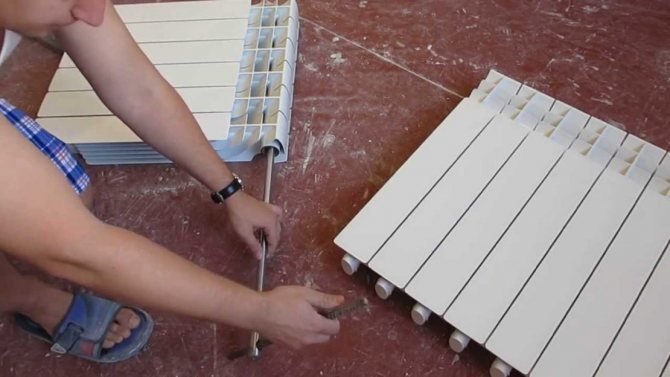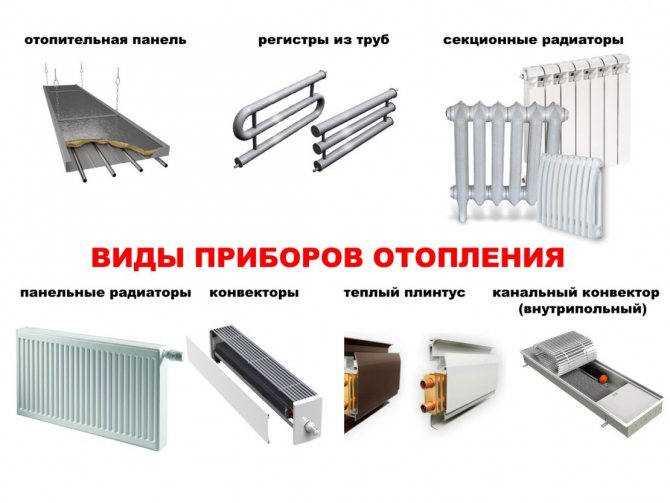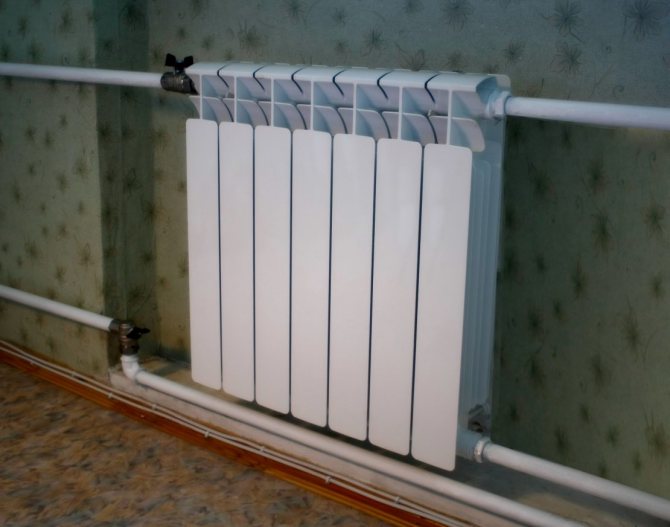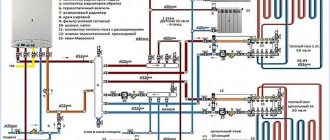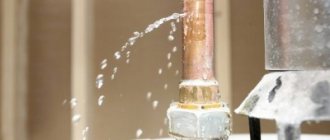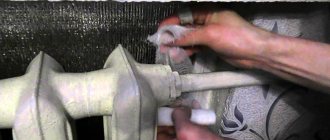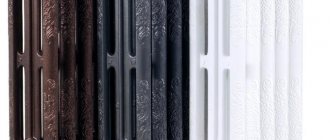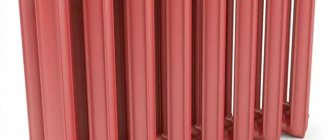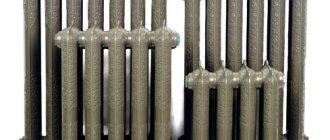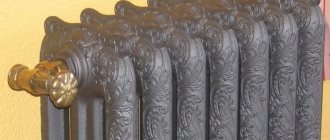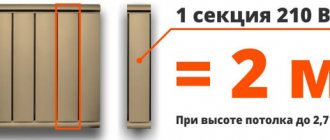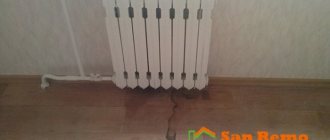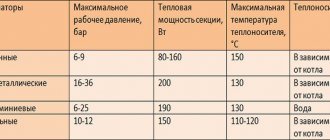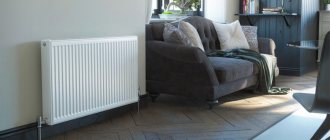Home heating systems imply the presence of radiators, which, when heated, give off heat to the room. Tanks for heating houses and apartments, made of cast iron, can serve for more than a dozen years. But no material, even as strong as cast iron, is capable of performing its functions forever. The time comes when it is necessary to repair cast iron batteries due to leaks, peeling paint or deterioration in the quality of their work.
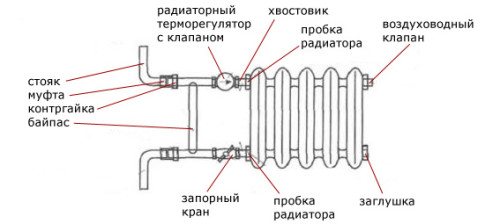
Diagram of the structure of the heating radiator.
Repairs can involve more than painting the battery. More serious measures are often taken to restore heating in the home. It is required to replace a part that cannot be restored, add or remove one of the sections, change pipe connections, etc. For the repair of heating indoor units, welding is required. Sometimes you can do it yourself.
Features of the repair of a cast iron battery
By its structure, cast iron differs from ordinary metal in fragility. The main feature of its repair is careful handling of the radiator. If a leak occurs, the damaged area should not be tapped against rust and scale. The blows inflicted will lead to the appearance of new microcracks, which will begin to expand when the hot coolant enters.
This also applies to cast iron radiators, which are flushed. Do not hit the sections with a metal hammer so that the dirt falls off faster. If disassembly into sections is provided, then the connecting nipples are unscrewed carefully. They are also cast iron and can crack.
Advice! In an old radiator, it is difficult to unscrew the connecting cast-iron nipples, since the threads are very sour. To simplify the situation, warming up with a blowtorch helps. Despite its massive weight, the cast-iron radiator is fragile and shock-resistant
If the leak can be repaired using a bandage method, then the area near the crack is simply cleaned out. Such actions will not destroy the cast iron walls of the section. Tapping is sometimes required during flushing. This can be done, but lightly and only with a wooden hammer.
Cast iron Soviet radiators after a long service life do not look aesthetically pleasing. Often, for this reason, they try to get rid of them. However, they can be turned into completely new batteries by taking advantage of another repair feature. It consists of four steps:
- The cast-iron old radiator is washed with chemical reagents. The action helps to clean the inside of the section from dirt, rust, solid salt deposits.
- The washed radiator is disassembled into sections. The section of the collector where you need to unscrew the cast-iron nipple is heated with a blowtorch.
- Each cast iron section is sandblasted from above. As a result, it cannot be distinguished from a new product.
- After cleaning, the cast iron sections are reassembled into a battery. New sealing rings are installed in the areas where the collectors are joined. If the nipples are bad, they are changed in the same way. It is optimal to replace the side plugs where the pipeline is connected to the radiator. Their thread will already be worn out, and leakage may appear in this place.
After the repair, a new radiator appears at the exit. It is these cast-iron batteries that are most often sold by firms after restoration, passing them off as a new product. Now it remains to paint and hang the radiator in its place.
How to give a proper look
The first thing you need to pay attention to is that the battery must perform well its main function - to give as much energy to the coolant as possible.It should not have the slightest hint of leaks (red spots between sections and on the plugs), since heating accidents are very expensive. Ideally, if possible, before restoration it is better to do the prophylaxis / tuning of the radiator: remove; Rinse; install shutoff valves, Mayevsky valve, thermal heads; replace problem seals. It is very desirable to remove it, because even painting work is better done on a workbench, and not “on site”.


It does not matter whether a decorative screen is subsequently installed or not, but you cannot get away from painting operations, nobody canceled the fight against corrosion. It all starts with preparation. It is necessary to remove the old paintwork, which has overgrown with many layers over the years (by the way, they greatly impair heat transfer). If the radiator is dismantled, then you can use a building hairdryer or blowtorch, paint remover will most likely not help here. So, we warm up the paint and clean it off with small spatulas. The next step is to remove rust and coating residues with a wire brush. To complete the action, the front surfaces should be covered with large emery. If the radiator cannot be removed, then you will have to limit yourself to the removal of flaking areas and careful grinding - the resulting cavities need to be cleaned "to naught".
Now the bare old battery is wiped from dust and degreased with a universal solvent. If we talk about chemistry, then it will not be superfluous first to treat hard-to-reach places with a rust converter. Well, since we have decided to do everything conscientiously, then we will prime the radiator with a special compound for metal products. The primer will improve adhesion, increase the product's resistance to corrosion, and “tint” the base well. The technique of applying the primer does not fundamentally differ from the finishing, more on that later.
Finally, the old battery is ready for painting. This exciting procedure can be done in various ways: with brushes, sponges, gloves, rollers, spray. In practice, the hybrid method has proven itself best of all: we paint the inner nooks with a curved brush or sponge, and the more accessible facial areas with a spray gun or a special roller.
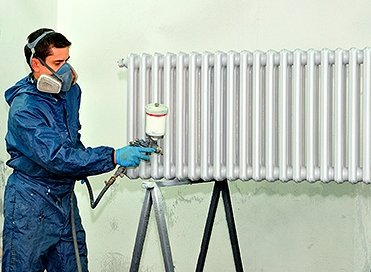

Note! Our task is to obtain the minimum thickness, reliable coating. The thinnest layer is given by a spray gun, then there is a sponge, then a brush and a roller.


You can formulate a number of simple rules and recommendations regarding the painting of an old battery. • First, we paint from the inside, otherwise the "facade" of the product can be damaged. • We cover the surfaces from top to bottom (relevant for a mounted radiator). • Watch for drips and remove them in time (especially after turning the battery over). • Be sure to paint completely. • Use a mirror to view the blind spots. • Two thin layers are more workable than one thick one. • It is necessary to paint a cold battery (there are exceptions). • The first layers can be improved by sanding. • Use specialized paintwork materials.
There are special paints on sale for finishing heating radiators. Oil compositions are a thing of the past, and acrylic, latex, alkyd paints have come to the fore. Their main advantage is resistance to high temperatures and household chemicals, mechanical durability, and relative harmlessness. There are formulations that can be applied directly to hot substrates.
All these paints can be easily tinted in any color from the main catalogs: PANTONE, RAL, NCS. Agree, it's boring to have a white radiator. Therefore, people are experimenting with might and main - they disguise the old battery to match the color of the wall, apply various metallics (gold, silver, hammer paint), play with effects (patina, mother-of-pearl, shine, chameleon, wood ...).
Why a cast iron battery can break
There are few reasons for the appearance of a defect on the cast-iron sections of the radiator, but they are. Malfunctions may even appear without leaking, which will result in poor battery performance. To find the right way to repair, you need to correctly determine the cause of the breakdown:
- Cast iron heating appliances are heavy. If they are suspended on weak brackets, they become skewed over time. The sections begin to "air" and do not heat. From weak brackets, the radiator is capable of breaking loose, breaking the pipeline. If dropped from the impact, cracks will appear on the cast iron sections. The wall of the section is capable of cracking from a water hammer
- Cast iron is weakly resistant to water hammer in the heating system, other mechanical influences caused by a person during installation. Even if the section is not cracked, a leak can appear at the joints.
- Clogging is a common cause of malfunction. Dirt and salt deposits settle inside the sections. Periodically, it is required to carry out major repairs with flushing with chemical reagents. The rubber rings on the connection of the section headers need to be changed periodically.
- At the junctions of the section collectors, rubber rings are installed. The gaskets wear out over time. The rubber is corroded by chemicals during flushing. During a major overhaul, the gaskets must be changed.
- The cause of a breakdown can be a banal defrosting of the radiator. For example, the owner does not appear at the dacha for a long time. In severe frosts, the coolant freezes in the heating system. From the expansion of water, the cast-iron section breaks.
It is not difficult to identify signs of breakdown. Cold areas indicate contamination or airborne radiator. If there is still no leak on the cast-iron surface, but a white or rusty coating has already appeared, this is the first "call" about the danger. It is impossible to delay the repair.
Advice! If the radiator shows several signs of malfunction at the same time, it is better to replace it. The dismantled battery is sent for overhaul.
Which batteries should you choose?
On the modern market, there are many models of radiators made of various alloys. Each has its own positive characteristics and features of use.
Aluminum batteries
Radiators from this material are produced in two types - cast and extruded. The former are a one-piece monolithic structure, while the latter are made of welded aluminum parts. Leaf-type batteries are more durable and more reliable.
Regardless of the type, aluminum radiators have common basic technical characteristics:
- section weight - from 1 to 1.47 kilograms;
- permissible maximum temperature of the coolant - 110 degrees;
- product power - from 82 to 212 watts;
- the maximum volume of liquid in one section is 0.46 liters;
- working pressure - from 6 to 24 atmospheres.
Aluminum batteries have been in production since the 1980s. Nowadays, the products have been quite improved and have not lost their popularity.
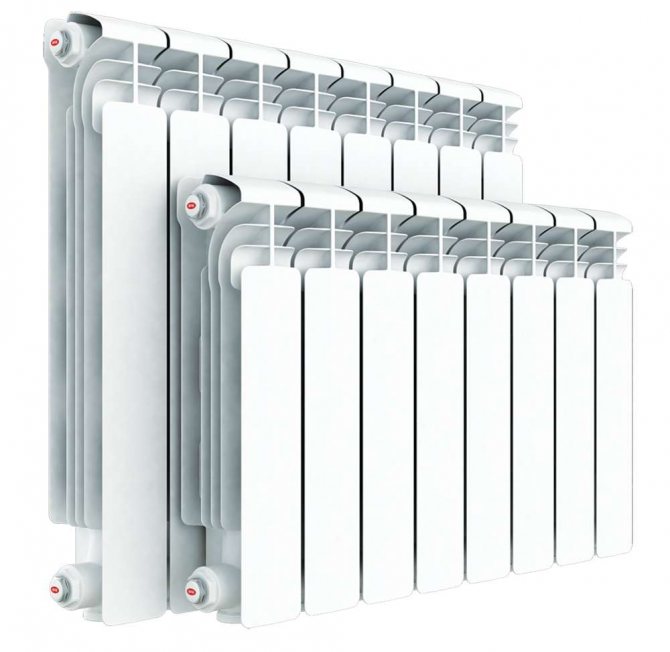

Aluminum batteries
The main advantages of aluminum heating radiators include:
- low weight of the product, contributing to its quick installation and transportation;
- a high level of heat transfer due to the rapid heating of the metal and the intensity of heat exchange;
- the ability to adjust the temperature even with a small volume of coolant;
- relatively low price of the product;
- good strength;
- decent appearance.
Along with the advantages of aluminum batteries, there are some disadvantages of use:
- low corrosion resistance;
- the possibility of formation due to a chemical process of air in the system.
If we take into account the extruded models, then we can highlight their weak point - threaded fasteners. With a sharp increase in pressure in the system, the integrity of the structure may be compromised.
Steel radiators
The installation of such radiators is justified in private houses with an autonomous local heating system. A feature of this type of device is:
- working pressure - from 6 to 13 atmospheres;
- the maximum water temperature in the battery is 110 degrees.
Despite the relatively low technical characteristics, steel radiators are very popular. The use of devices has the following advantages:
- compactness of structures;
- the possibility of temperature control due to the thermostat;
- high heat transfer rates;
- a wide variety of manufactured models;
- the cost is much lower than many new types of batteries being produced.
Among the disadvantages, the most significant are:
- incompatibility with an open-type heating system;
- susceptibility to corrosive effects;
- special requirements for the quality of the heat carrier used.
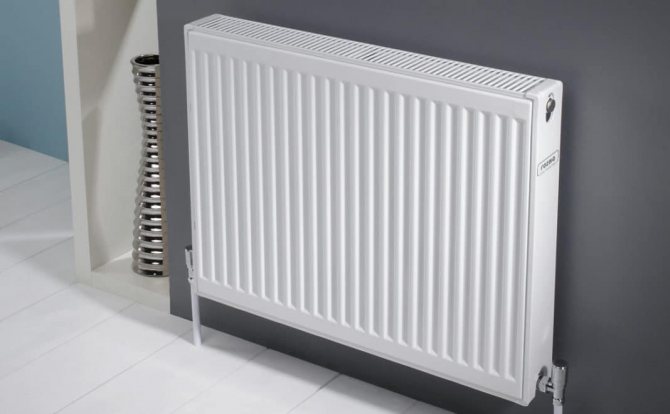

Steel radiators
The presence of various chemical impurities in the liquid used in the steel battery can cause material destruction. In this case, sometimes there is a leakage of the coolant due to violations of the tightness of the joints. Therefore, in multi-storey new buildings, steel radiators are not installed.
Bimetallic batteries
Radiators of this type are improved models that combine all the advantages of aluminum and steel products. The device has been widely used due to its high technical characteristics:
- maximum internal working pressure - 60 atmospheres;
- heat dissipation - up to 190 watts;
- the maximum temperature of the coolant is 110 degrees.
There are many advantages of using bimetallic radiators:
- long term operational - up to fifty years;
- high heat output and fast warming up of the room;
- good anti-corrosion properties;
- high level of strength;
- the ability to install additional sections;
- maximum sensitivity to thermostat commands;
- availability of models with various design solutions.
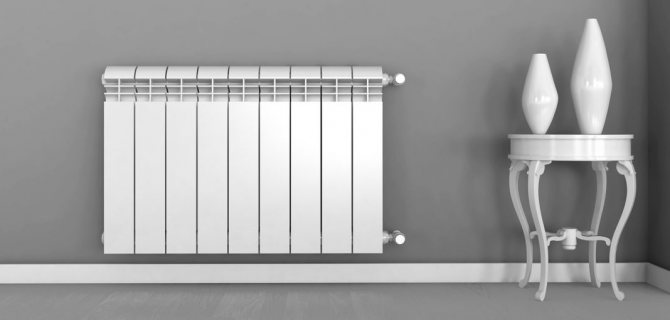

Bimetallic batteries
The material withstands the high hydraulic shocks typical of central heating systems.
The disadvantage of bimetallic radiators is the high price. As a rule, they are more expensive than aluminum or steel products. Cheap bimetallic batteries do not have corrosion protection, so over time the product will rust.
Methods for repairing cast iron heating batteries
The repair technology depends on the cause of the malfunction. If there is frequent airing due to skewing, the radiator is aligned horizontally on the wall, reinforced with additional brackets. When the sections are clogged, there is only one repair method - flushing with reagents.
When a leak appears, folk repair methods are often used:
- A small crack in the section is repaired by gluing it with epoxy resin with pieces of gauze. This method will help eliminate leaks on the pipe leading to the radiator or at the junction of the section headers. To eliminate the leak in an accessible area, a bandage impregnated with epoxy resin is wound
- The radiator manifold or supply pipe has a circular cross-section. To eliminate the leak will help the imposition of a clamp.
- Cold welding will help to seal the crack on the radiator. An emergency repair tool resembles plasticine, which must be kneaded with your hands and glued to a clean surface. Cold welding will help to quickly eliminate leaks
Each repair method is selected individually for a specific situation. It all depends on where the leak was formed.
How to repair a cast iron radiator
Repair begins with preparatory actions. A film is covered under the radiator, since water and dirt are indispensable here.It is important to know that if a method of gluing with epoxy resin or cold welding is chosen, then the radiator must be disconnected from the heating system, otherwise the coolant flow will prevent the bandage from sticking to the cast-iron surface. However, this can be done when the battery is equipped with shut-off valves.
Suppose there are taps on the piping to the radiator. They must be closed before starting repairs. The next step is to drain the coolant from the battery to eliminate the leak. The problem area is cleaned of paint, dirt, rust. Degrease with acetone or alcohol. Epoxy is applied to a strip of bandage or cotton fabric. If the crack is on a flat section, then the patch is simply glued in several layers, giving time for each of them to harden. On the section of the supply pipe or the collector, the tarred bandage is wound in the form of a bandage. After hardening, the area is painted over to match the color of the radiator.
The problem area is cleaned of paint and degreased before repair
Similar actions are performed when the repair of a cast-iron battery by cold welding is provided, but a bandage or a strip of cloth will be needed for other actions. The tool resembles plasticine. Before use, cut off the required amount of mass and knead it with your hands. During this time, the mixing of the components responsible for the curing of the cold welding takes place. The softened mass is glued to the area requiring repair. Try to wind a bandage on top with a strip of fabric. The harder the cold weld is pressed against the cast iron surface, the stronger the patch will be.
Advice! Instead of cloth, tape or strips of other material can be used to press down on the cold weld.
The clamp will help to eliminate the leak if it is impossible to disconnect the radiator from the heating system
In apartments with an old renovation, cast-iron radiators are installed without shut-off valves. Repair with epoxy resin or cold welding is not possible, as the coolant constantly leaks. If the problem area is on the pipe or the connection of the section manifolds, the clamp will help out. The product for the bandage consists of one split ring or two half rings. Bolts are provided for the screed. The rubber strip acts as a seal. The clamp is installed on the problem area, the bolts are tightened until the leak stops.
Overhaul requires complete disassembly of the radiator
If there is more than one leak, it is better to disassemble such a radiator immediately. Before that, it is disconnected from the heating system, the coolant is drained. Repairs are carried out in the following sequence:
- When a cast-iron battery is connected to the heating system with metal pipes that have served for more than a dozen years, it makes no sense to unwind the drives. They will end anyway. The threads are cut with a grinder. In their place, new squeegees will have to be welded.
- The radiator is removed from the brackets and placed on the floor. Using a wrench, they try to unscrew the plugs from the manifolds and the nuts with cut-off beads. It is important to remember that one manifold will have a right hand thread and the other a left hand thread. If the nuts do not go, they are heated with a blowtorch. After unscrewing on the plugs, the threads are cleaned with a metal brush. It is better to throw out nuts with cut off grips and buy new ones. It is difficult to unscrew the threaded tube pieces.
- To disconnect the sections, a special key is introduced into the collector. One end of it resembles a shoulder blade. It is with this flat part that they are looking for a hook on the antennae of a cast-iron nipple. It similarly has a right-hand and left-hand thread. They try to rip off the nipple with a key and turn it a couple of turns. If it does not give in, the collector section is heated with a blowtorch. A similar operation is performed on the opposite manifold. Each nipple is alternately turned a couple of turns until the section is completely disconnected.
Likewise, you can disassemble the entire radiator or separate damaged sections. If there is a lot of dirt inside, caustic soda is used for rinsing.A solution of 9% vinegar and water in a 1: 1 ratio is suitable. In extreme cases, a 5% sulfuric acid solution is used. For flushing, the liquid is poured into the radiator for a day, then washed with clean water. After these actions, the battery is disconnected into separate sections, the O-rings are changed, and the reassembly is performed.
In the video, you can learn more about the repair of heating radiators:
How can you restore old cast iron radiators
Maintenance and restoration of batteries can only be carried out before the start of the heating season. In order to establish the possibility of a breakthrough of pipes and radiators in winter, a preliminary check of heating systems is carried out. If the battery does not need flushing, then its repair can be carried out without removing the section from its place. The heater should be located at some distance from the wall; if it is built into a niche, restoration will be more difficult.
To dismantle the battery, you need to prepare the following tools:
- a key for radiators, suitable for nipple 5/4, if the battery is old, nipple 1 - for modern batteries;
- steel pipe for easy turning of the key (50-70 cm long);
- plumbing wrench No. 2, 3;
- a piece of chalk.
The restoration of cast-iron batteries begins with their dismantling and draining the remnants of the contents in the radiator cavity. The sections are laid on a horizontal surface. The extreme plug or footwear is removed. It should be remembered that the plugs have a left-hand thread, and the usual sleeves have a right-hand thread. Before starting work on the key, make a circular mark with chalk. To do this, combine the working part of the key with the nipple, which is planned to be unscrewed, and make a mark along the end of the section. A stop is placed under the free edge of the key - a brick or beams to avoid deflections when the cast-iron batteries are being restored.
Having thus prepared the battery for disassembly, you can begin to unscrew the sections by sliding the thread from its place. Parallel nipples are rotated alternately 5-7 mm wide between sections. It is better to work with two people in order to hold the radiator in the desired position. This will help avoid distortions. This is how sections in cast iron, aluminum and bimetallic heating radiators change.
Often old cast iron radiators do not lend themselves to mechanical stress due to rusted sections. The joints in the area of the nipple have to be heated with an autogenous one. Actions are carried out in a circular motion along parallel joints. After heating, the shorts are unscrewed. The battery with the replaced sections must be installed in the same place.
Professional advice
A few tips to help you make an effective renovation:
- After repair, the radiator will have to be painted. If it is hidden behind a decorative screen, it is advisable to choose a dark paint. A cast iron battery will better give off heat.
- The hanging brackets are positioned so that the gap between the radiator and the window sill is 10 cm, and the floor is 12-15 cm.
- To reflect heat, the wall behind the cast-iron battery is sealed with foil material.
Heating efficiency depends on the number of sections on each radiator. Here you need competent calculations, which will be helped by experienced specialists.
Bottom line: how should you wash to maintain the functionality of the system?
Repair of cast iron radiators is possible on your own, but only for minor defects. If you do not have the necessary tools or lack of experience, contact a professional plumber.
In addition to state-owned companies, there are many private companies. with the service of an urgent round-the-clock call of the master.
All home leakage and repair measures are temporary.
Therefore, after the end of the heating season invite specialists, to replace damaged sections or the entire radiator.The sooner this is done, the safer the home will become.
Heating devices, be it underfloor heating or radiators, are available in every apartment and even in a private house. Now there are many radiators, they differ in their weight, size, heat transfer, and price. Cast iron radiators have been used for a long time, they have proven themselves well, so some residents do not want to replace them with new batteries.
The analogs of this type of heating elements for premises are bimetallic radiators, they have a more interesting modern design, the metal content in them is low. When constructing new buildings, panel radiators are used with a large number of vertical channels.
Now a large number of people live in old houses that were built during the Soviet Union, it was in them that cast-iron batteries were installed, which showed themselves well over many years of operation. This type of radiator has good heat dissipation, therefore it heats the room well even in severe frosts. Due to the good technical characteristics of these radiators, many people do not see the point in replacing cast iron radiators with newer ones that are of good design. And it is not worth replacing them, the restoration of cast-iron radiators will breathe new life into them, because after painting with special paint, the old heating systems will have a stylish look, no worse than the new models.
Immediately after installation, the cast-iron batteries were painted with oil paint. Over the years, under the influence of constant temperature changes, the old paint faded and turned into a dirty, incomprehensible color, which significantly worsened the appearance of the product. In general, cast iron batteries are not bad, so they should be restored - it is better and cheaper than installing new, modern ones.
At the first stage of the restoration of cast iron radiators, the old paint coating should be removed. To do this, you can use a spatula or metal brush, which in some cases is capable of completely tearing off the old coating. To facilitate the procedure, use special impregnations that will destroy the coating.
Next, the battery surface is degreased, which includes dust removal followed by solvent treatment. This procedure will improve the adhesion of the paint layer to the surface.
To paint a radiator, you should purchase a paint that is intended to be applied on previously painted surfaces, in addition, it must be resistant to temperature extremes. It is better to paint the battery with two layers of paint, which will allow you to get a more uniform and saturated color.

